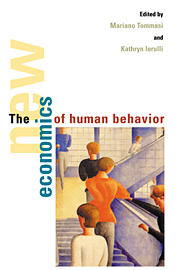Book contents
- Frontmatter
- Contents
- Contributors
- Preface
- Introduction
- PART I DISCRIMINATION AND IMMIGRATION
- 1 The economics of discrimination: a primer
- 2 The economic analysis of immigration
- PART II CRIME, PUNISHMENT, AND RIGHTS
- PART III ALL IN THE FAMILY
- PART IV GOVERNMENT AND POLITICS
- PART V HEALTH, RELIGION, AND MASS BEHAVIOR
- Index
2 - The economic analysis of immigration
Published online by Cambridge University Press: 03 December 2009
- Frontmatter
- Contents
- Contributors
- Preface
- Introduction
- PART I DISCRIMINATION AND IMMIGRATION
- 1 The economics of discrimination: a primer
- 2 The economic analysis of immigration
- PART II CRIME, PUNISHMENT, AND RIGHTS
- PART III ALL IN THE FAMILY
- PART IV GOVERNMENT AND POLITICS
- PART V HEALTH, RELIGION, AND MASS BEHAVIOR
- Index
Summary
Introduction
The 1980s were turbulent years in the history of immigration to the United States. Three major events characterized the demographic and political shifts. Auspiciously enough, the decade began with the Mariel boatlift. In April 1980, Fidel Castro decided to let Cuban nationals freely migrate to the United States, and over 125,000 people quickly took advantage of this offer. The Marielitos, as they came to be known, were responsible for substantial social disruptions in the Miami area, and the uncontrolled flow rekindled the debate over the type of refugee policy that a humanitarian and democratic welfare state should have.
The 1980s also witnessed an unsuccessful resolution to the political concern over illegal aliens that had been simmering over the past two decades. Fueled by charges that perhaps ten to twenty million illegal aliens were overrunning the country, Congress enacted the 1986 Immigration Reform and Control Act (IRCA). This legislation had two key provisions. The first gave amnesty to about three million illegal aliens, while the second introduced a system of employer sanctions that would presumably stem the flow of additional illegal workers. It is fair to conclude that the legislation is already a failure. Although the number of illegal aliens apprehended declined immediately following IRCA, apprehensions are now back up to about 1.2 million per year, roughly the same number of apprehensions observed in 1983.
- Type
- Chapter
- Information
- The New Economics of Human Behaviour , pp. 27 - 40Publisher: Cambridge University PressPrint publication year: 1995



